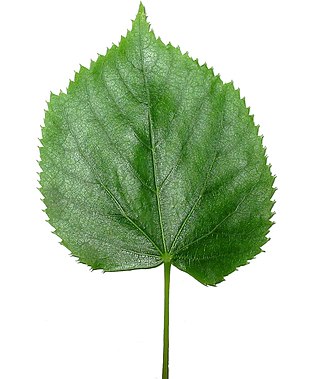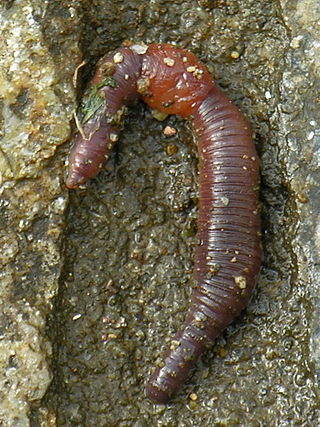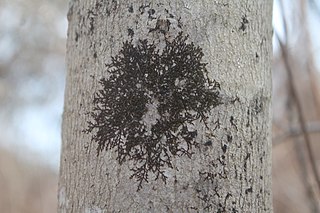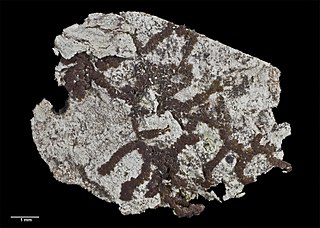Sheath, pronounced, may refer to:

A sporangium ; pl.: sporangia) is an enclosure in which spores are formed. It can be composed of a single cell or can be multicellular. Virtually all plants, fungi, and many other lineages form sporangia at some point in their life cycle. Sporangia can produce spores by mitosis, but in nearly all land plants and many fungi, sporangia are the site of meiosis and produce genetically distinct haploid spores.

Mosses are small, non-vascular flowerless plants in the taxonomic division Bryophytasensu stricto. Bryophyta may also refer to the parent group bryophytes, which comprise liverworts, mosses, and hornworts. Mosses typically form dense green clumps or mats, often in damp or shady locations. The individual plants are usually composed of simple leaves that are generally only one cell thick, attached to a stem that may be branched or unbranched and has only a limited role in conducting water and nutrients. Although some species have conducting tissues, these are generally poorly developed and structurally different from similar tissue found in vascular plants. Mosses do not have seeds and after fertilisation develop sporophytes with unbranched stalks topped with single capsules containing spores. They are typically 0.2–10 cm (0.1–3.9 in) tall, though some species are much larger. Dawsonia, the tallest moss in the world, can grow to 50 cm (20 in) in height. There are approximately 12,000 species.

The Marchantiophyta are a division of non-vascular land plants commonly referred to as hepatics or liverworts. Like mosses and hornworts, they have a gametophyte-dominant life cycle, in which cells of the plant carry only a single set of genetic information.

A leaflet in botany is a leaf-like part of a compound leaf. Though it resembles an entire leaf, a leaflet is not borne on a main plant stem or branch, as a leaf is, but rather on a petiole or a branch of the leaf. Compound leaves are common in many plant families and they differ widely in morphology. The two main classes of compound leaf morphology are palmate and pinnate. For example, a hemp plant has palmate compound leaves, whereas some species of Acacia have pinnate leaves.

In music, a thirty-second note (American) or demisemiquaver (British) is a note played for 1⁄32 of the duration of a whole note. It lasts half as long as a sixteenth note and twice as long as a sixty-fourth.

Serration is a saw-like appearance or a row of sharp or tooth-like projections. A serrated cutting edge has many small points of contact with the material being cut. By having less contact area than a smooth blade or other edge, the applied pressure at each point of contact is greater, and the points of contact are at a sharper angle to the material being cut. This causes a cutting action that involves many small splits in the surface of the material being cut, which cumulatively serve to cut the material along the line of the blade.

A gemma is a single cell, or a mass of cells, or a modified bud of tissue, that detaches from the parent and develops into a new individual. This type of asexual reproduction is referred to as fragmentation. It is a means of asexual propagation in plants. These structures are commonly found in fungi, algae, liverworts and mosses, but also in some flowering plants such as pygmy sundews and some species of butterworts. Vascular plants have many other methods of asexual reproduction including bulbils and turions.
A ligule is a thin outgrowth at the junction of leaf and leafstalk of many grasses and sedges. A ligule is also a strap-shaped extension of the corolla, such as that of a ray floret in plants in the daisy family Asteraceae.

The term incubous describes the way in which the leaves of a liverwort are attached to the stem. If one were to look down from above on a plant where the leaf attachment is incubous, the upper edge of each leaf would overlap the next higher leaf along the stem. Because of this, the upper edge of each leaf is visible from above, but the lower edge of each leaf is obscured by its neighboring leaf. The opposite of incubous is succubous.
This page provides a glossary of plant morphology. Botanists and other biologists who study plant morphology use a number of different terms to classify and identify plant organs and parts that can be observed using no more than a handheld magnifying lens. This page provides help in understanding the numerous other pages describing plants by their various taxa. The accompanying page—Plant morphology—provides an overview of the science of the external form of plants. There is also an alphabetical list: Glossary of botanical terms. In contrast, this page deals with botanical terms in a systematic manner, with some illustrations, and organized by plant anatomy and function in plant physiology.
This glossary of botanical terms is a list of definitions of terms and concepts relevant to botany and plants in general. Terms of plant morphology are included here as well as at the more specific Glossary of plant morphology and Glossary of leaf morphology. For other related terms, see Glossary of phytopathology, Glossary of lichen terms, and List of Latin and Greek words commonly used in systematic names.

A leaf is a principal appendage of the stem of a vascular plant, usually borne laterally aboveground and specialized for photosynthesis. Leaves are collectively called foliage, as in "autumn foliage", while the leaves, stem, flower, and fruit collectively form the shoot system. In most leaves, the primary photosynthetic tissue is the palisade mesophyll and is located on the upper side of the blade or lamina of the leaf but in some species, including the mature foliage of Eucalyptus, palisade mesophyll is present on both sides and the leaves are said to be isobilateral. Most leaves are flattened and have distinct upper (adaxial) and lower (abaxial) surfaces that differ in color, hairiness, the number of stomata, the amount and structure of epicuticular wax and other features. Leaves are mostly green in color due to the presence of a compound called chlorophyll which is essential for photosynthesis as it absorbs light energy from the sun. A leaf with lighter-colored or white patches or edges is called a variegated leaf.

In biology, metamerism is the phenomenon of having a linear series of body segments fundamentally similar in structure, though not all such structures are entirely alike in any single life form because some of them perform special functions. In animals, metameric segments are referred to as somites or metameres. In plants, they are referred to as metamers or, more concretely, phytomers.

Ptilidium is a genus of liverwort, and is the only genus in family Ptilidiaceae. It includes only three species: Ptilidium californicum, Ptilidium ciliare, and Ptilidium pulcherrimum. The genus is distributed throughout the arctic and subarctic, with disjunct populations in New Zealand and Tierra del Fuego. Molecular analysis suggests that the genus has few close relatives and diverged from other leafy liverworts early in their evolution.

Lophocolea heterophylla, the variable-leaved crestwort, is a liverwort species belonging to the order Jungermanniales, which is the largest liverwort order.
Notoscyphus balticus is an extinct species of liverwort in the family Geocalycaceae. The species is solely known from the Middle Eocene Baltic amber deposits in the Baltic Sea region of Europe. The genus contains a total of thirteen extant species distributed across the northern hemisphere.

Cyathophorum bulbosum, commonly known as quill moss or the false fern moss, is found in the eastern states of Australia as well as Papua New Guinea, New Zealand, Auckland Islands, Chatham Island, Lord Howe Island and possibly Norfolk Island and New Ireland.

Frullania eboracensis, the New York scalewort, is a species of liverwort in the family Frullaniaceae. New York Scalewort can be distinguished from other species of scalewort by its morphology. In particular, the small size, lower leaf lobes that are about as long as they are across, lower leaf lobes that are about one-third to one-half the size of upper leaf lobes, underleaves that are only a little wider than their stems. The underleaves of New York Scalewort have toothless or nearly toothless lateral margins, and perianths that have smooth to slightly roughened keels along their sides. Despite some distinctive morphology, microscopy is often necessary to confidently distinguish New York Scalewort from other species of Frullania, and the cells of the leaves have diagnostic irregular, jagged edges and cell walls are swollen at intervals.

Frullania wairua, the spirit liverwort or radar bush liverwort, is a species of liverwort in the order Porellales. It is one of 24 species in the large genus Frullania that are native to New Zealand. The species was first described by Matt von Konrat and John Braggins in 2005 in the New Zealand Journal of Botany.















